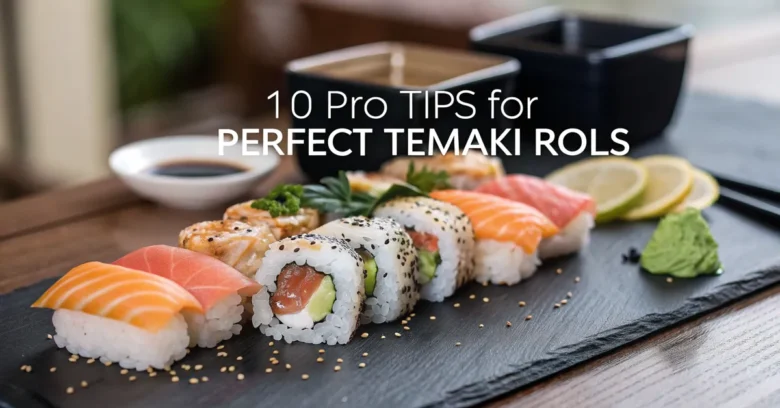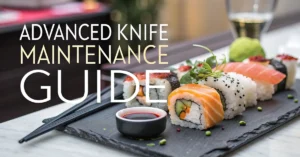Imagine biting into a perfectly crafted temaki roll: the crisp nori, the seasoned rice, the burst of fresh fillings. Seems simple, right? But crafting these handheld delights takes more than just slapping ingredients into seaweed. You need the right techniques and know-how to avoid soggy nori, uneven rolls, and fillings that spill out with every bite.
Whether you’re a seasoned sushi chef or a home cook eager to up your temaki game, this guide will equip you with ten pro tips to achieve temaki perfection. We’ll cover everything from rice preparation to filling selection and rolling techniques, ensuring your temaki rolls are both delicious and visually appealing.
10 Pro Tips for Perfect Temaki Rolls
Master the Sushi Rice
The foundation of any great sushi, including temaki rolls, is the rice. It’s not just about cooking rice; it’s about transforming it into sushi rice. The right balance of sweet, tangy, and slightly firm grains elevates the entire experience.
-
Choose the Right Rice: Opt for short-grain Japanese rice, often labeled as “sushi rice.” These varieties have a higher starch content, resulting in the necessary stickiness for holding the temaki together. Avoid long-grain rice, as it will not bind properly.
-
Wash Thoroughly: Rinse the rice under cold water until the water runs clear. This removes excess starch, preventing a gummy texture. Gently rub the grains together to release the starch effectively. It may take 5-7 rinses.
-
Cook It Right: Use a rice cooker for optimal results. Add the rice and water according to the rice cooker’s instructions. Typically, this is a 1:1 ratio of rice to water. If cooking on the stovetop, bring the water to a boil, then reduce heat to low, cover, and simmer for 15 minutes. Let it steam, covered, for another 10 minutes after cooking.
-
Season Like a Pro: While the rice is still warm, gently transfer it to a large, non-metallic bowl. Prepare the sushi vinegar (awasezu). A standard ratio is 2 tablespoons of rice vinegar, 2 teaspoons of sugar, and 1 teaspoon of salt per cup of uncooked rice. Heat the vinegar mixture gently until the sugar and salt dissolve, but do not boil.
-
The Cutting Motion: Slowly drizzle the sushi vinegar over the rice while using a rice paddle (shamoji) to gently cut and fold the rice. Avoid mashing the grains. The goal is to evenly distribute the vinegar while cooling the rice quickly. Fan the rice with a hand fan or a piece of cardboard to expedite the cooling process. This gives the rice a glossy sheen. The rice should be at room temperature before rolling.
Select the Freshest Fillings
Temaki rolls are a canvas for creativity, but the quality of your fillings is paramount. The best temaki rolls boast a harmonious blend of textures and flavors, all built upon the foundation of freshness.
-
Prioritize Freshness: Source the freshest possible seafood, vegetables, and other ingredients. Look for vibrant colors, firm textures, and a clean, ocean-like aroma for seafood.
-
Consider Texture and Flavor Balance: Aim for a mix of textures, such as creamy avocado, crunchy cucumber, and succulent fish. Complementary flavors are also key. For instance, spicy tuna pairs well with cool cucumber and a drizzle of mayonnaise.
-
Prepare Ingredients Properly: Cut all fillings into manageable sizes – thin strips or small cubes work best. This makes the temaki easier to roll and eat. Pat dry any wet ingredients, like tofu, to prevent soggy nori.
Nori Know-How
The nori seaweed sheet is your wrapper, and its quality significantly impacts the final product.
-
Choose High-Quality Nori: Look for nori sheets that are dark green, slightly shiny, and have a crisp texture. Avoid brittle or dull-colored nori, as it may be stale.
-
Toast Briefly (Optional): Lightly toasting the nori sheet before rolling can enhance its flavor and crispness. Pass it quickly over a low flame or a hot pan, being careful not to burn it. Toasting is a great way to rejuvenate nori that has lost some of its crispness.
Master the Rolling Technique
The art of rolling temaki lies in achieving a secure, cone-shaped roll that holds its contents without being too tight or too loose.
-
Prepare Your Workspace: Have a bowl of clean water nearby to moisten your fingers. This will prevent the rice from sticking to your hands. A damp towel is also useful for wiping your hands.
-
Position the Nori: Hold a sheet of nori in your non-dominant hand. Imagine the sheet as a diamond. Place it so one of the corners points towards you.
-
Rice Distribution: With moistened fingers, spread a thin layer of sushi rice over the lower half of the nori sheet, leaving the top corner empty. Do not overfill – about 1/4 cup of rice is usually sufficient.
-
Add Fillings: Arrange your chosen fillings diagonally across the rice, near the center. Avoid overfilling, as this will make the temaki difficult to roll.
-
Rolling Time: Bring the bottom corner of the nori up and over the fillings, tucking it underneath to form a cone shape. Moisten the top corner with a dab of water to seal the roll.
-
Gentle Firming: Gently press the roll to secure the shape. Hold it for a few seconds to allow the nori to adhere.
The Art of Serving and Enjoying Temaki
Temaki is best enjoyed fresh, right after rolling. Presenting them attractively and providing the right accompaniments enhances the overall experience.
-
Serve Immediately: Temaki rolls are best eaten immediately after rolling, while the nori is still crisp.
-
Presentation Matters: Arrange the temaki rolls attractively on a platter or a sushi board.
-
Provide Accompaniments: Offer soy sauce for dipping, pickled ginger (gari) to cleanse the palate, and wasabi for an extra kick.
-
Embrace Variety: Encourage your guests to experiment with different fillings and create their own unique temaki combinations.
Elevating Your Temaki Experience
Beyond the basics, consider these advanced tips to truly impress your guests:
-
Infused Rice: Experiment with infusing your sushi rice with subtle flavors. A touch of yuzu zest or a few drops of sesame oil can add a unique dimension.
-
Gourmet Sauces: Offer a variety of gourmet sauces beyond soy sauce. Spicy mayo, eel sauce (unagi sauce), or a homemade ginger-scallion sauce can elevate the flavor profile.
-
Edible Garnishes: Garnish your temaki with edible flowers, microgreens, or toasted sesame seeds for an elegant touch.
Common Temaki Mistakes and How to Avoid Them
Even experienced sushi makers can fall prey to common temaki pitfalls. Here’s how to sidestep them:
-
Soggy Nori: Avoid overfilling the temaki or using wet ingredients without patting them dry. Prepare the temaki just before serving to minimize nori’s exposure to moisture.
-
Uneven Rolls: Practice makes perfect. Ensure the rice is evenly distributed and the fillings are arranged diagonally for a consistent shape.
-
Fillings Falling Out: Do not overfill the temaki. Secure the roll tightly by tucking the bottom corner firmly and sealing the top corner properly.
Temaki Variations to Explore
The beauty of temaki lies in its versatility. Once you’ve mastered the basic technique, feel free to experiment with endless variations:
-
Spicy Tuna Temaki: Combine diced tuna with sriracha mayo, sesame oil, and green onions for a fiery kick.
-
California Temaki: A classic combination of imitation crab meat, avocado, cucumber, and sesame seeds.
-
Vegetarian Temaki: Use a variety of fresh vegetables, such as bell peppers, carrots, sprouts, and avocado, along with tofu or tempeh for added protein.
-
Smoked Salmon Temaki: Pair smoked salmon with cream cheese, dill, and capers for a Scandinavian-inspired twist.
Health and Nutritional Benefits of Temaki
Beyond their deliciousness, temaki rolls offer a range of nutritional benefits:
-
Omega-3 Fatty Acids: Seafood fillings, such as salmon and tuna, are rich in omega-3 fatty acids, which are beneficial for heart health and brain function.
-
Fiber: Nori seaweed is a good source of fiber, which aids digestion and promotes gut health.
-
Vitamins and Minerals: Vegetables provide essential vitamins and minerals, contributing to overall well-being.
-
Protein: Fish, tofu, and other protein-rich fillings help build and repair tissues.
The Tools of the Temaki Trade
While you don’t need specialized equipment to make temaki, a few key tools can make the process easier and more enjoyable:
-
Rice Cooker: Ensures perfectly cooked sushi rice every time.
-
Rice Paddle (Shamoji): For gently mixing and cooling the sushi rice.
-
Sharp Knife: For precisely cutting the fillings.
-
Sushi Rolling Mat (Makisu): Although not essential for temaki, it can be helpful for shaping the rolls more firmly.
-
Sushi Board: For presenting the temaki rolls attractively.
Temaki as a Social Culinary Experience
Making temaki can be a fun and interactive activity for gatherings. Set up a temaki bar with a variety of fillings and let your guests create their own personalized rolls.
-
Temaki Party: Invite friends and family to a temaki-making party. Provide a selection of ingredients and let everyone create their own custom rolls.
-
Interactive Dining: Encourage guests to share their creations and offer tips to each other.
-
Dietary Considerations: Be mindful of any dietary restrictions or allergies among your guests and provide suitable alternatives.
Diving Deeper: The Science Behind Sushi Rice
The unique qualities of sushi rice aren’t accidental. A fascinating science underlies its preparation.
-
Amylose and Amylopectin: Short-grain Japanese rice has a specific ratio of amylose and amylopectin, two types of starch. The higher amylopectin content is what makes it sticky when cooked.
-
Gelatinization: Cooking the rice gelatinizes the starch, allowing the grains to absorb water and become tender.
-
Retrogradation: Cooling the rice after seasoning causes retrogradation, a process where the starch molecules realign, resulting in a slightly firmer texture.
Debunking Common Temaki Myths
Several misconceptions surround temaki rolls. Let’s set the record straight:
-
Myth: Temaki is Difficult to Make: While perfection takes practice, the basic rolling technique is relatively simple and can be mastered with a few tries.
-
Myth: You Need Exotic Ingredients: While you can use premium ingredients, delicious temaki can be made with readily available and affordable options.
-
Myth: Temaki is Only for Seafood Lovers: Vegetarian and vegan temaki options are equally delicious and can cater to a wider audience.
Storing Leftover Temaki Ingredients
Properly storing leftover temaki ingredients will help maintain their freshness and quality:
-
Sushi Rice: Store leftover sushi rice in an airtight container in the refrigerator. It’s best consumed within 24 hours. Reheat it gently in the microwave before using.
-
Seafood: Store seafood in an airtight container in the refrigerator. Consume it within 1-2 days.
-
Vegetables: Store vegetables in the refrigerator in airtight containers.
-
Nori: Store nori sheets in an airtight container in a cool, dry place. Exposure to air and moisture will cause them to become stale.
The Global Appeal of Temaki
Temaki rolls have transcended their Japanese origins and gained global popularity.
-
Cultural Fusion: Temaki lends itself well to cultural fusion. Experiment with incorporating flavors and ingredients from different cuisines.
-
DIY Trend: The DIY nature of temaki makes it a popular choice for home cooks and food enthusiasts.
-
Restaurant Staple: Temaki is a common offering in sushi restaurants around the world.
The Final Verdict: Crafting Unforgettable Temaki
Mastering temaki is a journey of culinary exploration. By heeding these tips, you’ll be well on your way to creating exceptional temaki rolls that impress your guests and tantalize your taste buds. The key is fresh ingredients, a balance of flavors and textures, and a touch of creativity. So, gather your ingredients, sharpen your knives, and embark on your temaki adventure.



